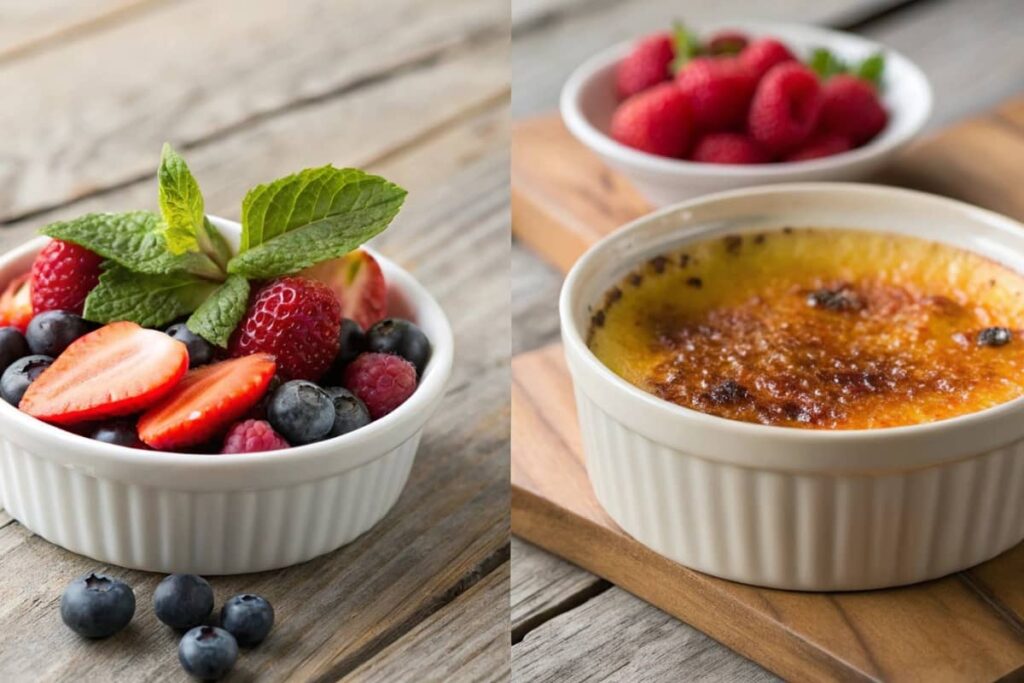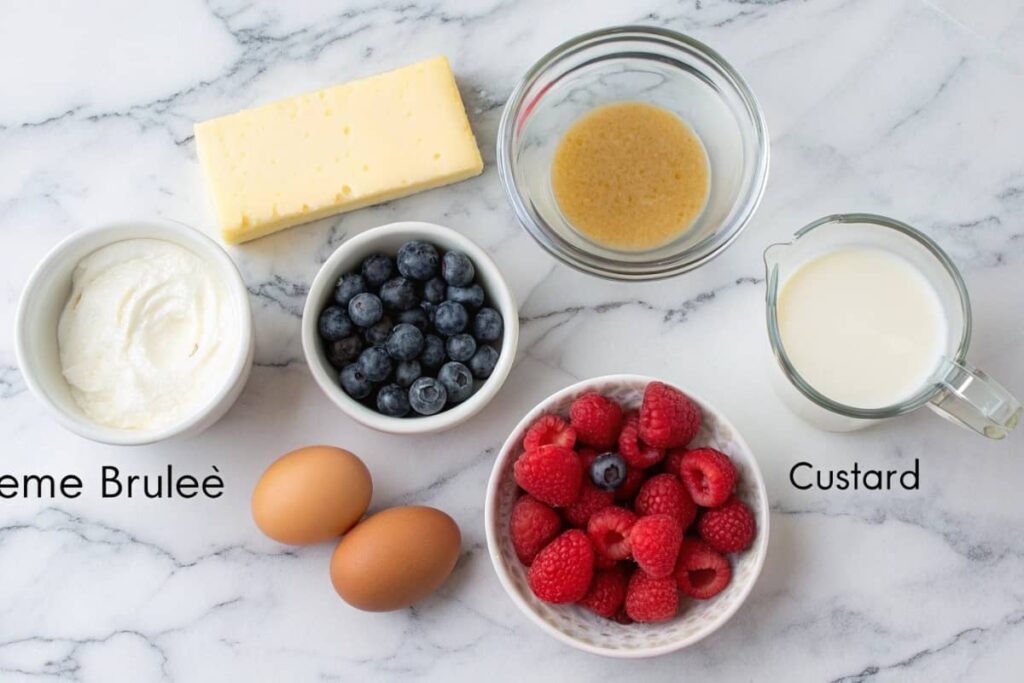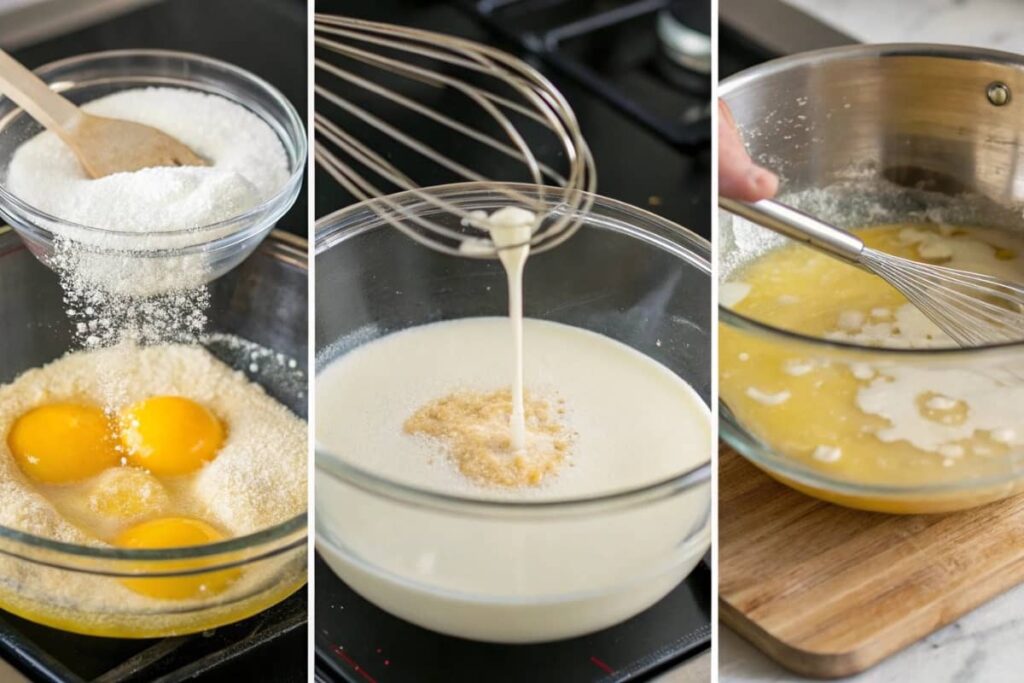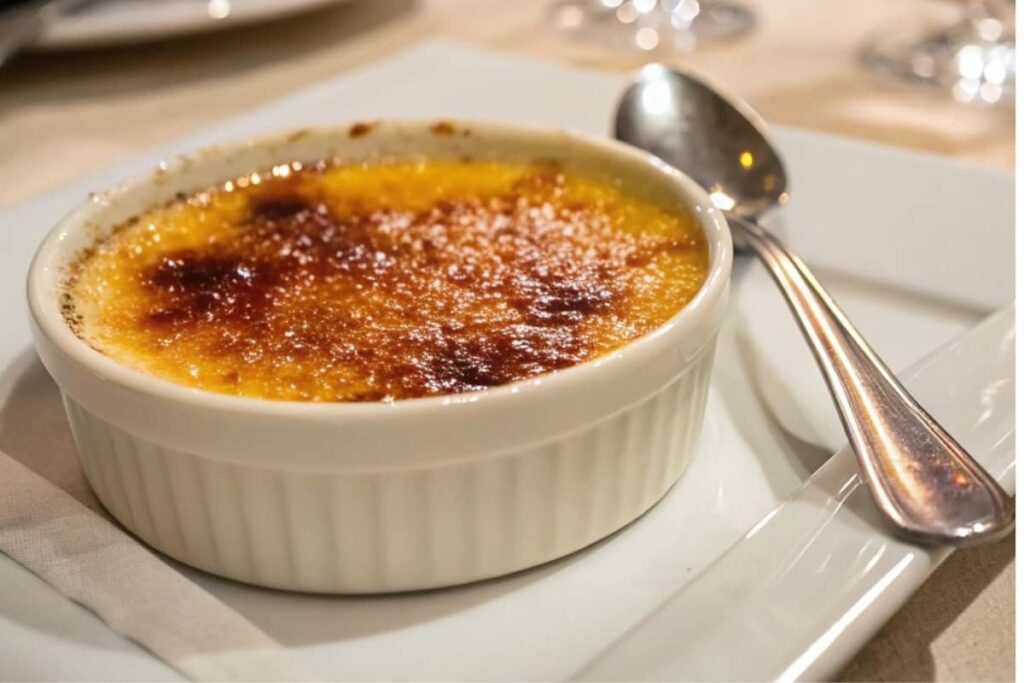Crème brûlée and custard are two classic desserts loved for their creamy texture and rich flavor. But while they might look similar, they have distinct differences in terms of ingredients, cooking methods, and taste.
If you’ve ever wondered, “What sets crème brûlée apart from custard?”, this guide is for you. We’ll explore:
✔ The history and origins of both desserts
✔ Key differences in ingredients and cooking techniques
✔ Nutritional comparison and healthier alternatives
✔ Popular recipes you can try at home
By the end, you’ll be a dessert expert, ready to impress with your knowledge or even whip up these delicious treats yourself.
Table of Contents
What is Crème Brûlée?
Crème brûlée is a rich, creamy dessert known for its crispy caramelized sugar topping. The name means “burnt cream” in French, reflecting its signature feature—a layer of caramelized sugar that you crack through with a spoon.
History and Origins of Crème Brûlée
The origins of crème brûlée are debated, with France, Spain, and England all claiming to have invented it.
| Country | Name | Key Difference |
|---|---|---|
| France | Crème Brûlée | Classic version with caramelized sugar |
| Spain | Crema Catalana | Uses lemon zest and cinnamon |
| England | Trinity Cream | First made at Trinity College, Cambridge |
The first recorded recipe appeared in France in 1691 by chef François Massialot, who described the process of caramelizing sugar with a hot iron. It became popular in English and French high society and is now a fine-dining staple worldwide.
Key Ingredients and Flavor Profile
Crème brûlée is known for its rich, velvety texture and sweet, creamy flavor.
| Ingredient | Purpose | Flavor Profile |
|---|---|---|
| Heavy Cream | Creates a rich, creamy texture | Smooth and velvety |
| Egg Yolks | Thickens the custard | Adds richness |
| Sugar | Sweetens and caramelizes on top | Sweet and slightly burnt |
| Vanilla Extract | Classic flavoring | Warm and aromatic |
Optional Add-Ins:
- Chocolate – For a richer, decadent taste
- Espresso – Adds a bold, coffee flavor
- Fruit Puree – Raspberry or mango for a fruity twist
Cooking Method and Texture
Crème brûlée is made using a gentle baking process:
- Mixing: Heavy cream, sugar, egg yolks, and vanilla are mixed until smooth.
- Baking: The mixture is poured into ramekins and baked in a water bath to ensure even cooking.
- Chilling: Once set, the custard is chilled for several hours to develop its creamy texture.
- Caramelizing: Just before serving, sugar is sprinkled on top and caramelized with a blowtorch to create a crisp, glassy layer.
✅ Why It’s Unique: The contrast between the creamy custard and the crunchy caramelized sugar makes crème brûlée a sensory delight.
Unique Features: Caramelized Sugar Topping
The caramelized sugar topping is what makes crème brûlée iconic. It’s made by:
- Sprinkling a thin, even layer of sugar on the chilled custard.
- Using a kitchen blowtorch to melt and caramelize the sugar.
- Allowing it to cool for a few minutes, forming a crisp shell.
Fun Fact: The best part of eating crème brûlée is cracking through the caramelized layer with a spoon. It’s a satisfying experience that makes this dessert a favorite.
What is Custard?
Custard is a creamy, versatile dessert made from a mixture of milk or cream, egg yolks, and sugar. It can be served hot or cold, and its texture varies from soft and pourable to firm and sliceable.
History and Origins of Custard
Custard has a long history dating back to Ancient Rome, where eggs were used as thickeners in savory dishes. However, it wasn’t until the Middle Ages that custard became sweet, flavored with honey, spices, and fruit.
| Era | Development |
|---|---|
| Ancient Rome | Eggs were used to thicken sauces |
| Middle Ages | Custard became sweet with sugar and spices |
| Renaissance | Baked custards and tarts became popular in Europe |
Custard spread throughout Europe, leading to regional variations like Crème Anglaise (France) and Flan (Spain). Today, it’s a staple in desserts worldwide.
Key Ingredients and Flavor Profile
The basic custard uses a simple mix of ingredients:
| Ingredient | Purpose | Flavor Profile |
|---|---|---|
| Milk or Cream | Main liquid for the base | Smooth and creamy |
| Egg Yolks | Thickens the mixture | Rich and silky |
| Sugar | Adds sweetness | Sweet and light |
| Vanilla Extract | Common flavoring | Warm and aromatic |
Optional Flavors:
- Cinnamon and Nutmeg – For a warm, spiced taste
- Citrus Zest – Adds a fresh, tangy flavor
- Chocolate – Creates a rich, indulgent custard
✅ Why It’s Versatile: Custard can be flavored in endless ways, making it a base for many desserts like pies, trifles, and ice cream.
Cooking Method and Texture
Custard can be baked, stirred, or set depending on the desired texture:
| Type | Cooking Method | Texture |
|---|---|---|
| Baked Custard | Oven-baked in a water bath | Firm and sliceable |
| Stirred Custard | Cooked on stovetop | Smooth and pourable |
| Set Custard | Thickened with gelatin | Firm and wobbly |
✅ Baked custards are more like a creamy pudding, while stirred custards are pourable, often used as a sauce.

Key Differences Between Crème Brûlée and Custard
Although crème brûlée and custard share similar ingredients, they have key differences in texture, flavor, and cooking methods. Let’s break down what sets them apart.
Ingredients Comparison
While both desserts use eggs, sugar, and dairy, they differ in the type of dairy and the use of toppings.
| Ingredient | Crème Brûlée | Custard |
|---|---|---|
| Dairy | Heavy cream (rich, velvety) | Milk or half-and-half (lighter) |
| Eggs | Mostly yolks (for richness) | Whole eggs or yolks (varies by type) |
| Sweetener | Sugar (caramelized topping) | Sugar (mixed in the custard) |
| Toppings | Caramelized sugar crust | Typically none (can have fruit or caramel) |
✅ Crème brûlée is richer and creamier due to heavy cream and extra egg yolks, while custard is lighter and more versatile.
Texture and Consistency
The texture is one of the biggest differences between the two desserts.
| Dessert | Texture | Consistency |
|---|---|---|
| Crème Brûlée | Silky, velvety, firm | Smooth, creamy custard with a crispy top |
| Custard | Varies (soft to firm) | Can be pourable, wobbly, or sliceable |
- Crème brûlée is firm and creamy beneath a crisp caramelized layer.
- Custard can be soft and pourable (like crème anglaise) or firm and sliceable (like flan).
✅ Why It Matters: Crème brûlée’s crunchy caramel topping adds a textural contrast not found in custard.
Cooking Techniques
Both desserts use gentle cooking methods to avoid curdling, but the techniques are different.
| Cooking Method | Crème Brûlée | Custard |
|---|---|---|
| Baking | Water bath in oven | Water bath or stovetop |
| Caramelization | Blowtorch to melt sugar | None (except for flan or caramel custard) |
| Serving Temperature | Chilled, with warm caramelized top | Can be served warm or cold |
✅ Crème brûlée is always baked then chilled before torching the sugar, while custard can be baked, stirred, or chilled depending on the type.
Toppings and Presentation
Crème brûlée is known for its signature caramelized sugar crust, while custard is usually topped with fruit or served plain.
| Dessert | Topping | Presentation Style |
|---|---|---|
| Crème Brûlée | Caramelized sugar crust | Served in ramekins |
| Custard | Fruit, caramel, or plain | Served in bowls, cups, or as pie filling |
✅ Crème brûlée is often presented as an elegant fine-dining dessert, while custard is more casual and versatile.

Nutritional Comparison: Which is Healthier?
Both desserts are rich and indulgent, but they differ in calories, fat, and sugar content.
Calorie Count and Macronutrients
| Dessert | Calories (Per Serving) | Fat (g) | Carbs (g) | Protein (g) |
|---|---|---|---|---|
| Crème Brûlée | 300-400 | 25 | 30 | 6 |
| Custard | 200-300 | 10 | 25 | 5 |
✅ Custard is generally lower in calories and fat because it uses milk instead of heavy cream.
Sugar and Fat Content
Crème brûlée has more sugar and fat due to its caramelized topping and heavy cream base.
| Dessert | Sugar (g) | Fat Type | Cholesterol (mg) |
|---|---|---|---|
| Crème Brûlée | 25-30 | Saturated (from cream) | 200-250 |
| Custard | 15-20 | Less saturated | 100-150 |
✅ Custard is a lighter option with less sugar and saturated fat.
Healthier Alternatives and Substitutions
You can make both desserts healthier with a few substitutions:
| Ingredient | Healthier Swap | Benefit |
|---|---|---|
| Heavy Cream | Coconut cream or almond milk | Lower calories, dairy-free |
| Sugar | Stevia or monk fruit | Lower glycemic index |
| Egg Yolks | Egg whites or whole eggs | Less cholesterol, lower fat |
| Caramelized Topping | Coconut sugar or erythritol | Lower sugar content |
✅ Best Tip: For a lighter crème brûlée, use coconut cream and monk fruit sweetener. For custard, swap whole milk for almond milk.
Flavor Variations and Add-Ins
Both desserts are versatile and can be flavored in many ways:
| Flavor | Crème Brûlée | Custard |
|---|---|---|
| Vanilla | Classic and elegant | Smooth and comforting |
| Chocolate | Decadent, rich | Silky, indulgent |
| Fruit (Mango, Raspberry) | Fruity contrast to rich cream | Refreshing and light |
| Spices (Cinnamon, Nutmeg) | Warm and aromatic | Cozy and flavorful |
✅ Crème brûlée often has a luxurious feel with bold flavors, while custard is more comforting and versatile.
How to Serve Crème Brûlée vs. Custard
| Crème Brûlée | Custard |
|---|---|
| Chilled with a warm, crisp top | Can be served warm or cold |
| Served in ramekins with a caramelized sugar crust | Served in cups, bowls, or as pie filling |
| Garnished with fresh berries or mint | Topped with fruit, caramel, or whipped cream |
✅ Crème brûlée is best served chilled with a warm, crackable top, while custard is more flexible in serving temperature and presentation.
Best Pairings and Garnishes
- Crème Brûlée: Fresh berries, whipped cream, or biscotti
- Custard: Caramel sauce, fruit compote, or shortbread cookies
✅ Pair crème brûlée with dessert wines like Sauternes or Moscato. Custard pairs well with coffee or tea.

Which is Easier to Make?
If you’re deciding which dessert to try at home, you might be wondering, “Is crème brûlée or custard easier to make?” Let’s compare the difficulty level, equipment needed, and common mistakes for each.
Difficulty Level and Required Equipment
| Dessert | Difficulty Level | Required Equipment |
|---|---|---|
| Crème Brûlée | Intermediate | Ramekins, blowtorch, water bath |
| Custard | Easy to Intermediate | Saucepan, whisk, baking dish |
✅ Crème brûlée is more complex because it requires precise caramelization with a blowtorch and careful water bath baking to avoid curdling.
✅ Custard is simpler and can be made with basic kitchen tools, especially if using the stovetop method.
Common Mistakes to Avoid
Both desserts are sensitive to temperature and timing. Here are the most common mistakes and how to avoid them:
Crème Brûlée
| Mistake | What Happens? | How to Fix It |
|---|---|---|
| Overcooking | Custard becomes grainy | Bake until the center is slightly jiggly |
| Burning the Sugar | Bitter, burnt taste | Hold the blowtorch 2 inches away and move in circles |
| Using Cold Eggs | Mixture curdles | Use room temperature eggs for even blending |
✅ Pro Tip: Always strain the custard mixture before baking to remove bubbles for a silky-smooth texture.
Custard
| Mistake | What Happens? | How to Fix It |
|---|---|---|
| High Heat | Curdling and lumps | Cook on low heat and stir constantly |
| Not Straining | Lumpy texture | Strain the mixture before cooking |
| Overbaking | Rubber-like consistency | Bake until just set, with a slight wobble in the center |
✅ Pro Tip: For stirred custards, use a double boiler to maintain gentle, even heat.

Popular Recipes to Try at Home
Ready to get cooking? Here are classic recipes for both desserts, along with modern twists for adventurous bakers.
Classic Crème Brûlée Recipe
Ingredients
- 2 cups heavy cream
- ½ cup granulated sugar (plus extra for topping)
- 5 egg yolks
- 1 teaspoon vanilla extract
- Fresh berries (optional, for garnish)
Instructions
1️⃣ Preheat the Oven
- Preheat oven to 325°F (163°C).
- Arrange 4 ramekins in a deep baking dish.
2️⃣ Heat the Cream
- In a saucepan, heat the heavy cream over medium heat until hot (not boiling).
- Remove from heat and stir in vanilla extract.
3️⃣ Mix the Custard Base
- In a bowl, whisk egg yolks and sugar until pale and creamy.
- Slowly add the warm cream while whisking continuously.
4️⃣ Strain and Pour
- Strain the mixture to remove any bubbles or lumps.
- Divide evenly among the ramekins.
5️⃣ Bake in a Water Bath
- Pour hot water into the baking dish, reaching halfway up the ramekins.
- Bake for 35-40 minutes until the edges are set but the center is slightly jiggly.
6️⃣ Chill and Caramelize
- Chill for at least 2 hours (or overnight).
- Before serving, sprinkle sugar evenly on top and caramelize with a blowtorch.
7️⃣ Serve and Enjoy
- Let the sugar cool and harden for a few minutes.
- Garnish with fresh berries and serve chilled.
| Difficulty | Prep Time | Cook Time | Chill Time | Servings |
|---|---|---|---|---|
| Intermediate | 15 min | 40 min | 2 hours | 4 |
✅ Crème brûlée is worth the effort for its silky custard and crunchy caramel top.
Simple Vanilla Custard Recipe
Ingredients
- 2 cups whole milk
- ½ cup granulated sugar
- 3 egg yolks
- 1 tablespoon cornstarch
- 1 teaspoon vanilla extract
Instructions
1️⃣ Heat the Milk
- In a saucepan, heat the milk until warm (not boiling).
2️⃣ Mix Egg Yolks and Sugar
- In a bowl, whisk egg yolks, sugar, and cornstarch until smooth.
3️⃣ Combine and Cook
- Slowly pour the warm milk into the egg mixture, whisking continuously.
- Return the mixture to the saucepan and cook on low heat, stirring constantly until thickened.
4️⃣ Add Vanilla and Strain
- Remove from heat and stir in vanilla extract.
- Strain to ensure a smooth texture.
5️⃣ Chill and Serve
- Pour into serving bowls and chill for at least 1 hour.
- Serve cold, plain or topped with fruit.
| Difficulty | Prep Time | Cook Time | Chill Time | Servings |
|---|---|---|---|---|
| Easy | 10 min | 10 min | 1 hour | 4 |
✅ This simple custard is versatile and can be used as a base for other desserts.
Modern Twists to Try
- Chocolate Crème Brûlée: Replace vanilla with melted dark chocolate.
- Fruit Custard: Add fruit puree (mango, strawberry, or passionfruit) for a fruity version.
- Spiced Crème Brûlée: Infuse the cream with cinnamon, nutmeg, or chai spices.
✅ Experiment with flavors to make each dessert your own!
Print
Crème Brûlée Recipe
- Total Time: 2 hours 55 minutes (including chilling)
- Yield: 4 serving 1x
- Diet: Vegetarian
Description
Crème brûlée is a classic French dessert known for its rich, creamy custard base topped with a layer of caramelized sugar. It features a silky texture and a satisfying crack when you break through the caramelized crust. Perfect for an elegant and indulgent treat.
Ingredients
- 2 cups heavy cream
- ½ cup granulated sugar (plus extra for topping)
- 5 egg yolks
- 1 teaspoon vanilla extract
- Fresh berries (optional, for garnish)
Instructions
Preheat the Oven:
- Preheat oven to 325°F (163°C).
- Arrange 4 ramekins in a deep baking dish.
Heat the Cream:
- In a saucepan, heat the heavy cream over medium heat until hot (not boiling).
- Remove from heat and stir in vanilla extract.
Mix the Custard Base:
- In a bowl, whisk egg yolks and sugar until pale and creamy.
- Slowly add the warm cream while whisking continuously.
Strain and Pour:
- Strain the mixture to remove any bubbles or lumps.
- Divide evenly among the ramekins.
Bake in a Water Bath:
- Pour hot water into the baking dish, reaching halfway up the ramekins.
- Bake for 35-40 minutes until the edges are set but the center is slightly jiggly.
Chill and Caramelize:
- Chill for at least 2 hours (or overnight).
- Before serving, sprinkle sugar evenly on top and caramelize with a blowtorch.
Serve and Enjoy:
- Let the sugar cool and harden for a few minutes.
- Garnish with fresh berries and serve chilled.
Notes
- Tip: For the best caramelized crust, use superfine sugar for the topping.
- Storage: Crème brûlée can be stored in the refrigerator for up to 3 days without the caramelized topping.
- Prep Time: 15 min
- Cook Time: 40 min
- Category: Desserts
- Method: Baking
- Cuisine: frensh
Nutrition
- Serving Size: 1 serving
- Calories: 350
- Sugar: 27g
- Sodium: 50mg
- Fat: 27g
- Saturated Fat: 17g
- Unsaturated Fat: 10g
- Trans Fat: 0 g
- Carbohydrates: 30g
- Fiber: 0g
- Protein: 5g
- Cholesterol: 200mg
Keywords: Crème Brûlée Recipe
Conclusion
Crème brûlée and custard may look similar, but their differences in texture, cooking methods, and flavor make them distinctly unique.
Key Takeaways:
✔ Crème brûlée is richer and creamier with a crispy caramelized topping, while custard is lighter and more versatile.
✔ Custard is generally lower in calories and sugar, making it the healthier option.
✔ Crème brûlée requires more skill and equipment, but the textural contrast is worth the effort.
✔ Both desserts are highly versatile, with endless flavor variations and serving styles.
✔ If you’re a beginner, start with custard, but for an elegant treat, try making crème brûlée.
Whether you’re craving the elegance of crème brûlée or the comfort of custard, you can now make an informed choice (or try both)!
Would you like more dessert comparisons or recipes? 🚀




